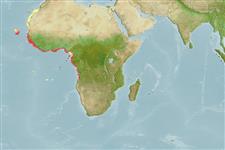Environment: milieu / climate zone / depth range / distribution range
Écologie
marin démersal; profondeur 20 - 300 m (Ref. 127989). Tropical; 33°N - 13°S, 27°W - 15°E (Ref. 5222)
Eastern Atlantic: Western Sahara to Angola, including Cape Verde and the Sao Tome and Principe islands. Also recorded from the Mediterranean.
Length at first maturity / Taille / Poids / Âge
Maturity: Lm 18.0 range ? - ? cm
Max length : 70.0 cm TL mâle / non sexé; (Ref. 27000); common length : 40.0 cm TL mâle / non sexé; (Ref. 26999)
Description synthétique
Clés d'identification | Morphologie | Morphométrie
Épines dorsales (Total) : 9; Rayons mous dorsaux (Total) : 15 - 16; Épines anales: 3; Rayons mous anaux: 9 - 10. Distinguished by the following characteristics: body depth less than head length, 2.8-3.2 in SL; head length 2.7-3.0 in SL; interorbital area convex; rounded preopercle, finely serrate, with shallow notch, fleshy lower edge; subopercle and interopercle with few small serrae covered by skin; maxilla reaching vertical at rear edge of eye or beyond; pectoral fins longer than pelvic fins, pectoral fin length contained 1.5-1.7 in HL; pelvic fins reaching or nearly reaching anus; caudal fin rounded; lateral-body scales ctenoid, without auxiliary scales (Ref. 089707).
Found on sandy and rocky bottoms (Refs. 32181, 127989). Diandric protogynous hermaphrodite (Ref. 089707).
Life cycle and mating behavior
Maturities | Reproduction | Spawnings | Egg(s) | Fecundities | Larves
Pelagic spawner (Ref. 32181). Low ratio of males in population correlated with polygamy (Ref. 32181). This study (Ref. 32181), concluded that some males of C. taeniops may not pass through a functional female stage as observed in most groupers, and that these males may have developed directly from immature females conferring with the hypothesis of Shapiro (1987). Diandric (Ref. 103751).
Heemstra, P.C. and J.E. Randall, 1993. FAO Species Catalogue. Vol. 16. Groupers of the world (family Serranidae, subfamily Epinephelinae). An annotated and illustrated catalogue of the grouper, rockcod, hind, coral grouper and lyretail species known to date. Rome: FAO. FAO Fish. Synop. 125(16):382 p. (Ref. 5222)
Statut dans la liste rouge de l'IUCN (Ref. 130435)
Menace pour l'homme
Harmless
Utilisations par l'homme
Pêcheries: intérêt commercial mineur
Outils
Articles particuliers
Télécharger en XML
Sources Internet
Estimates based on models
Preferred temperature (Ref.
123201): 15.8 - 20.7, mean 19.2 °C (based on 47 cells).
Phylogenetic diversity index (Ref.
82804): PD
50 = 0.5000 [Uniqueness, from 0.5 = low to 2.0 = high].
Bayesian length-weight: a=0.00977 (0.00645 - 0.01482), b=3.10 (2.98 - 3.22), in cm total length, based on LWR estimates for this species & Genus-body shape (Ref.
93245).
Niveau trophique (Ref.
69278): 4.5 ±0.80 se; based on food items.
Generation time: 8.1 ( na - na) years. Estimated as median ln(3)/K based on 2
growth studies.
Résilience (Ref.
120179): Faible, temps minimum de doublement de population : 4,5 à 14 années (Preliminary K or Fecundity.).
Fishing Vulnerability (Ref.
59153): High vulnerability (56 of 100).
Nutrients (Ref.
124155): Calcium = 82.6 [45.8, 179.5] mg/100g; Iron = 0.778 [0.383, 1.684] mg/100g; Protein = 17.9 [16.1, 19.6] %; Omega3 = 0.273 [0.144, 0.501] g/100g; Selenium = 83.4 [38.1, 179.9] μg/100g; VitaminA = 22.7 [7.7, 77.2] μg/100g; Zinc = 0.732 [0.466, 1.255] mg/100g (wet weight);
